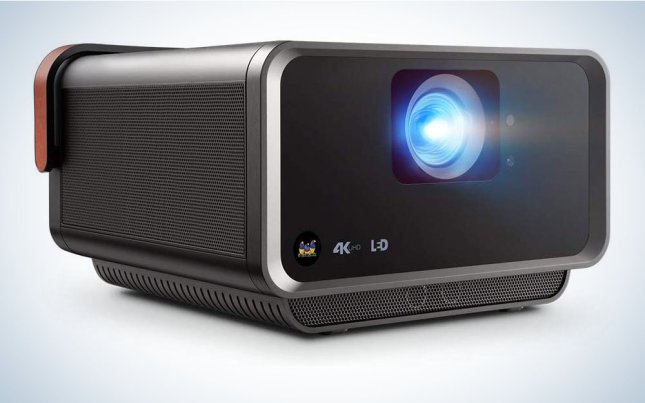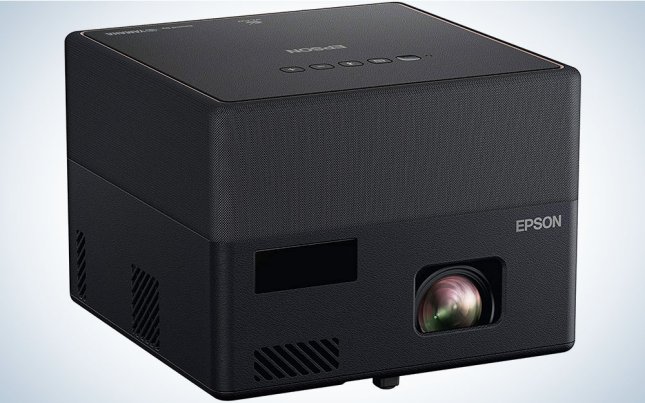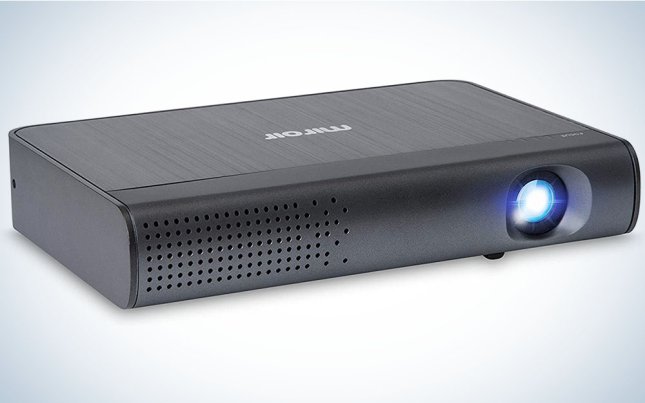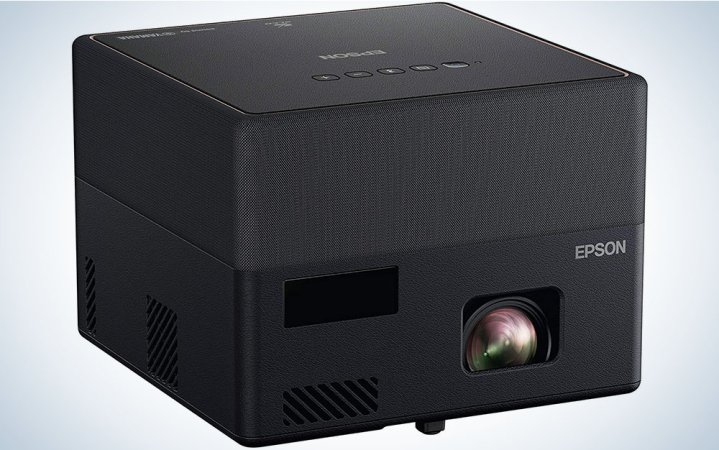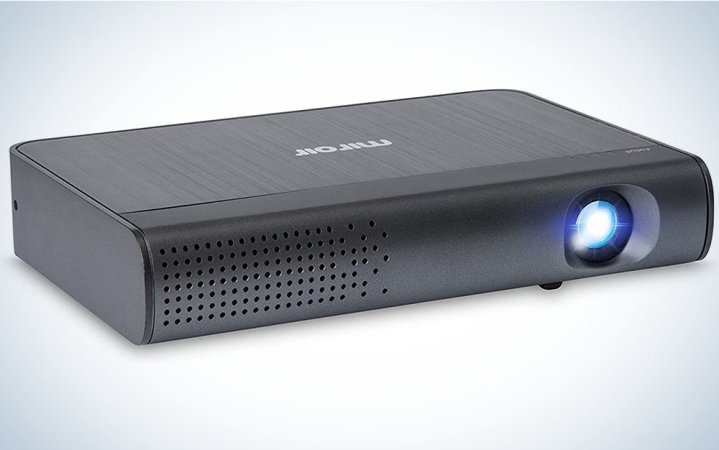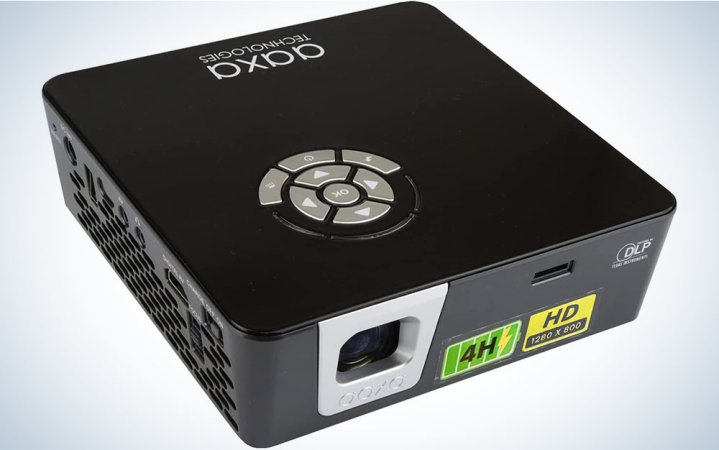We may earn revenue from the products available on this page and participate in affiliate programs. Learn more ›
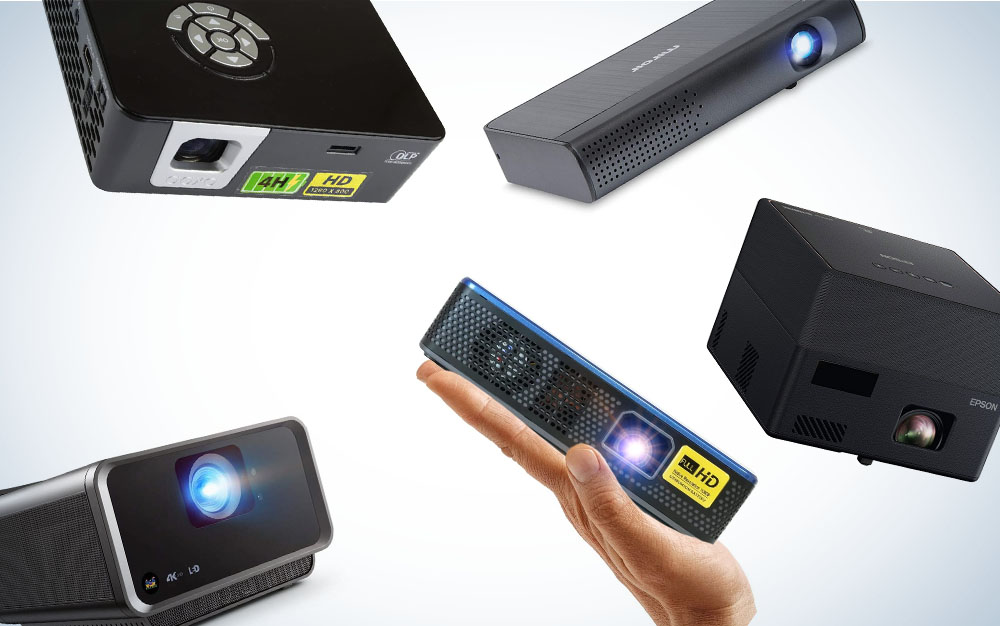
The best portable projectors produce big, bright images for a cinema-like experience. But, at the same time, they pack all that power into units that can go places the best home theater projectors can’t. These options are small and light enough to take anywhere—from the living room to the bedroom, on family vacations, or even out camping in the woods. They’re ideal for anyone who makes presentations at work or school, with units small enough to fit in a backpack, shoulder bag, or briefcase.
No one wants to lug around extra source components like a Blu-ray player, so many of the best portable projectors accept HD or 4K content from streaming sticks, SD cards, or USB keys. In fact, some projectors have smart TV and streaming capabilities built in. A well-rounded portable projector also delivers surprisingly robust audio—again, who wants to haul speakers when you can have all the equipment built into one device? Some projectors even run on battery power for truly off-the-grid viewing.
The projector market is saturated with units designed to replace the TV as your main source for programs and movies. To help you wade through all the options, we surveyed the choices to offer you our picks for the best portable projectors.
- Best 4K: ViewSonic X10-4KE
- Best for movies: Epson EpiqVision Mini EF12
- Best budget: Miroir M289
- Best mini-sized: AAXA M7
- Best for presentations: AAXA P6X
How we selected the best portable projectors
To select our picks for the best portable projectors, we looked at 14 different units from eight different companies. We combined staff experiences with critical and user opinions to narrow down the choices and dug into the manufacturer’s spec sheets to find out how the projectors performed and whether they lived up to their manufacturer’s promises. We evaluated our choices by comparing brightness, contrast ratios, and color accuracy, as well as people’s overall impressions of picture quality. Since portable units are often taken out of people’s main movie rooms, we also focused on the quality of built-in audio—a movie isn’t any good if you can’t hear it. Of course, we looked at each projector’s size and weight and evaluated the ease of traveling with it. Battery life was also a consideration, as was ease-of-setup.
Things to consider before buying the best portable projectors
It’s easy to become confused by the specs underlying video projectors, and the terminology might seem confusing at times. Thankfully, when you break it down, the product details can help you choose the best pick for your unique situation. So here are a few things to consider before purchasing a portable projector:
Light it up
When buying a projector, shine a light on the number of lumens offered. Lumens describe how much light a projector creates and that, in turn, determines how bright and large your picture will be—especially in less than ideal situations where you can’t achieve a completely dark room. Unfortunately, different companies measure lumens in different ways, so comparisons between units aren’t always clear-cut when the numbers are close. A projector that puts out a reported 1,800 lumens might not actually have much more light than one with a reported 1,500 lumens. In fact, it might not be brighter at all! On the other hand, if one projector claims 2,000 lumens—and another delivers 1,000—it’s safe to assume the former is the brighter unit.
Chips and dip
Projectors use imaging chips to create a picture and those come in three types: DLP (Digital Light Processing), LCD (Liquid Crystal Display), and LCoS (Liquid Crystal on Silicon). DLP chips and LCD chips crop up in products across many price ranges, while LCoS chips tend to appear in higher-end products. DLP often delivers better contrast than LCD, but the latter tends to win on color. Additionally, units with single DLPs can suffer from a “rainbow” effect, where colors sometimes flash momentarily in areas of extreme brightness. Many people don’t notice them or don’t find them bothersome, while, for others, this quality may be a deal-breaker.
Size matters
Portable projectors aren’t exactly portable if they’re too heavy to carry in one hand or can’t fit into a backpack. When looking at projectors, pay attention to the physical specs; they might not make a difference if you planned on leaving the unit sitting in your living room, but you’ll appreciate it if you spend a lot of time carrying your tech from one place to another!
Pico and palmtops
Pico projectors, also sometimes called pocket projectors, are about the size of a smartphone. This makes them extremely portable, of course, but they’re generally dimmer than most other projectors, with a price-to-performance ratio that leaves something to be desired. Palmtop projectors are larger and brighter than pico projectors, with more connections, and lightweight enough to drop into a bag for travel or presentations.
Pico and palmtops don’t often need bulky external content sources; they can run files from USB drives and sometimes SD cards. They often feature rechargeable batteries, which makes them convenient when on the road and far from an outlet.
Power Up
If you plan on traveling with your projector to the office, a friend’s house, or any other place with an outlet, power won’t be an issue. But if you’ve got dreams of watching romantic movies—or, my personal choice, deep-space adventures—under the stars, then you’ll need something with enough battery life to get you through the feature. Nothing’s worse than reaching the final scene and having the projector go dark!
Game on
If you plan on using a portable projector for gaming, pay attention to the unit’s refresh rate, which is usually between 60Hz and 240Hz, as well as its lag time. The higher the refresh rate—the faster the pixels can change images—and the lower your lag time. Lower lag times translate into faster on-screen reactions to your button-mashing. Many projectors have variable refresh rates depending on the resolution. So, for instance, when playing 4K games, the refresh rate might be 60Hz, while playing 1080p games allows the projector to have a 120Hz refresh rate.
Additional features
Other things to look for in higher-end projectors include lens shift, which helps you adjust the picture up and down or side to side without having to move the projector; motorized lenses that make it more convenient to focus; and throw distance. That last spec determines the distance required between the projector and its screen or surface. Short-throw projectors are excellent for small spaces because they can generate a larger image from closer. But long-throw projectors can sit comfortably in the back of a room in, for instance, an entertainment unit. Knowing how and where you plan on using the unit will help determine how much throw distance you’ll need. (The distances generally have the flexibility to accommodate various settings and situations since no two spaces are exactly the same.) And, if you’re using an external source, make sure you have the best HDMI cable for the job (and maybe even know how to connect a soundbar to beef up the audio presentation of your projector).
The best portable projectors: Reviews & Recommendations
Best 4K portable projector: ViewSonic X10-4KE 4K UHD Projector
Ultra High-Def Perfection
Why it made the cut: Though a bit chunky at 9 pounds, this projector provides 4K video and high-quality audio for an all-in-one portable entertainment system.
Specs
- Weight: 9 pounds
- Product Dimensions (HWD): 6.5 inches by 10.3 inches by 10.7 inches
- Brightness: 2,400 lumens
Pros
- 4K resolution
- High-quality stereo audio
- Integrated streaming and smart-home features
Cons
- Color needs tweaking out of the box
- Loss of details in shadows
- Too much lag time for gaming
As the best 4K portable projector the ViewSonic X10-4KE packs a punch into a small and portable—if slightly heavy—package, using pixel-shifting technology to get 4K video out of a 1080p DLP chip. A lamp-free red-green-blue LED light source boosts color accuracy and brightness (plus a 30,000-hour lifespan) for an excellent, ongoing image in dark rooms as well as ones with low ambient light. The projector does need some fiddling with settings to get the best image (which includes Rec. 709 color accuracy and HDR content support), but once it’s set you won’t have to deal with it again.
The short-throw projector casts 4K and HD sources up to 200 feet. It also has built-in smart-home and streaming features built on the Android OS, so you won’t need an external Blu-ray player or laptop—that’s a plus in the portability department.
Two 8-watt Harman Kardon speakers serve up powerful, stereo sound that can easily fill a living room. The projector also features analog and digital audio ports and Bluetooth output for external speakers. As with all single-chip DLP projectors, the ViewSonic X10-4KE might show rainbow artifacts in particularly bright areas. While not everyone notices them, it’s worth considering when looking at this projector for your home.
Best portable projector for movies: Epson EpiqVision Mini EF12 Smart Streaming Laser Projector
Sharp and Punchy Picture
Why it made the cut: Even though it’s only 1080p, Epson’s EpiqVision Mini EF12 has a three-chip LCD that delivers high contrast ratios and accurate color.
Specs:
- Weight: 4.7 pounds
- Product Dimensions (HWD): 5.3 inches by 6.9 inches by 6.9 inches
- Brightness: 1,000 lumens
Pros
- Laser light source lasts longer than a bulb
- Three-chip LCD imaging for higher contrast and accurate color
- Integrated smart TV and streaming apps
- Supports 4K content (downconverted to 1080p)
Cons
- Only 1,000 lumens
- No true 4K resolution
The Epson EpiqVision Mini EF12 is the best portable projector for movies because its multi-array laser diode technology uses a three-chip LCD to play movies with sharp contrast and beautiful, accurate colors (using scene-adaptive color correction) at up to 150 feet. It can accommodate both HD and 4K sources (with HDR support) through its two HDMI ports, though higher-resolution movies are downconverted to 1080p.
Epson’s projector is a full-entertainment center in a box, with Android TV and Google Play Store apps. Download all your favorite streaming services and then settle in to watch movies and binge-able TV without ever having to carry along an external player.
The EpiqVision Mini EF12 also has muscular sound, provided by built-in, dual 5-watt Yamaha speakers. A 3.5mm output jack, HDMI ARC, and Bluetooth connect the unit to external audio systems—which is a nice feature to have when traveling.
Best affordable portable projector: Miroir M289 Portable LED Projector
Affordable and Portable
Why it made the cut: This simple-to-use, portable projector has impressive color and audio for the price, making it the best affordable portable projector for both business presentations and movies.
Specs:
- Weight: 27.5 ounces
- Product Dimensions (HWD): 1.4 inches by 6.9 inches by 4.8 inches
- Brightness: 400 lumens
Pros
- MSRP under $400
- Accurate color
- Can use any streaming stick
- Built-in, four-hour battery
Cons
- No image controls
- One HDMI port
The tote-sized, 27-ounce Miroir M289’s DLP chip easily delivers a sharp 1080p image at up to about 100 inches thanks to its 400-lumen red-green-blue LED light source. And it does it just about anywhere thanks to a built-in 5200 mAh, li-polymer, rechargeable battery for up to 2 hours of uninterrupted viewing time (or use it as a battery backup for mobile devices).
This portable projector is designed for streaming, with a USB input compatible with streaming sticks of your choice, and one HDMI input that accepts up to 4K material (then downconverted) from an external media player or a laptop. There’s no way to adjust the image, but colors and contrast are reasonably good out of the box whether you’re watching movies or making presentations. The unit has three buttons (on/off, volume up/down), a focus control, and automatic keystone correction.
The 3-watt stereo speakers sound good, with enough volume to fill a meeting room. Audio outputs can connect to stereo speakers. While this isn’t a top-of-the-line projector, so you can’t expect it to compete with units costing three or four times as much, the Miroir performs solidly for this price point.
Best mini portable projector: AAXA M7 Full HD Portable DLP Projector
Palm-Size Power
Why it made the cut: Sitting comfortably in the palm of your hand, the best mini portable projector, the AAXA M7 pushes out a sharp-looking, bright 1080p picture.
Specs
- Weight: 3 pounds
- Product Dimensions (HWD): 1.85 inches by 7.3 inches by 6.4 inches
- Brightness: 1,200 lumens
Pros
- 1080p resolution
- Bright image for size and class
- Powered focus
- Small enough for a briefcase or bag
Cons
- Color could be more accurate
- Doesn’t support HDR content
The M7 from AAXA is a tiny, but powerful portable projector that easily slips inside your bag or briefcase to bring to business meetings. It also serves as a movie projector for unwinding after a day of work.
This 1080p unit (4K 30FPS ready) has a higher resolution than many projectors of this size. The picture from the 1,200-lumen quad-cast LED light source looks good even when blown up to around 200 inches. Using power from the 15,000mAh, 3-hour rechargeable battery, though, that drops to 650 lumens. It has a bit of a green-shift that isn’t too noticeable unless you use boost mode to raise the brightness. Darker scenes are a bit soft on detail, but not so much as to make them unwatchable.
Dual 4-watt speakers are loud enough for a night of movies, though the audio sounds a little thin—not entirely unexpected from a projector of this size. Of course, external speakers can be attached via a 3.5mm stereo output.
Best portable projector for presentations: AAXA P6X Battery-Powered Portable Mini Projector
Taking Care of Business
Why it made the cut: The AAXA P6X’s 1280 by 800 resolution, bright image, and high contrast deliver presentations that pop, while its small size makes it easy to take on the road.
Specs
- Weight: 1.8 pounds
- Product Dimensions (HWD): 1.85 inches by 6.25 inches by 6.2 inches
- Brightness: 1,000 lumens
Pros
- Small and lightweight
- Bright for its class
- Excellent contrast and shadow details
- Four-hour battery
Cons
- Movies don’t look as good
- Focus is difficult to adjust
Anyone who travels for business and needs to make presentations will appreciate the small size and light weight of AAXA’s P6X mini projector. It’s easy to set up, too, so meetings won’t get held up by tech issues making it our choice for best portable projector for presentations.
The 1280 by 800 resolution isn’t Full HD, but this isn’t a unit designed for watching movies—though you can certainly do so if you’d like. Instead, the DLP chip in this 1,100 lumens (plugged in) pico projector produces images up to 160 inches with high contrast that makes graphics look sharp and punchy. Details emerge from shadows, and colors are vibrant on this brightest-meets-lightest option.
The unit features an HDMI input that accepts 1080p sources, as well as a microSD slot and two USB Type-A ports. A full set of controls on top of the projector is mirrored on the slim, included remote control. It runs off of a 15,000mAh powerbank, which can also charge other devices. The P6X doesn’t have a carrying case, however, so consider picking one up to protect it from the dings of road life.
FAQs
You can watch Netflix on a mini projector, along with content from any other streaming service. However, to feed the content to the projector, you’ll need either a streaming stick, if the projector accepts one, or else a streaming box with HDMI outputs, like a Roku. Once those are connected, you’ll have access to Netflix (assuming you subscribe) and any other streaming apps you’d normally find on your traditional TV.
If you’re camping, you’ll want a projector that can run on battery power. However, these rarely last more than four hours, so be sure to look for a unit that also accepts USB power from an external battery backup unit. Since your internet connection is likely not too good in the middle of the woods, and there’s nowhere to plug in a Blu-ray player, choose a portable projector that accepts either a memory stick or SD card—that way, you can bring your movies along as files that can play directly through the unit itself. Finally, don’t forget audio! If you’re alone, you can easily use headphones when watching your favorite movies. But if you’re with friends or family, look for a unit that has a built-in speaker, or that can output to battery-powered speakers using a 3.5mm jack or Bluetooth. And don’t forget to bring something to use as a screen! Dedicated home theater screens are best, but if you’re trying to keep things light, a bright, white surface should do the trick.
A portable projector is legit! Portable projectors can play HD and 4K movies and deliver presentations without getting tied down to one location. Many portable projectors run on batteries along with AC power for even greater portability, and smaller palmtop and pico projectors fit comfortably in backpacks and briefcases. Some projectors have stereo speakers for excellent built-in sound that can fill a living room or conference room, and all connect to external speakers if you want more robust audio. Finally, many portable projectors include Smart TV and streaming capabilities so you can download apps and play TV and movies from services like Amazon, Netflix, Hulu, and more. These powerful units become stand-alone entertainment centers. Now, that’s legit!
The final word on the best portable projectors
The best portable projector is the Epson EpiqVision Mini EF12. Its high-definition image shines brightly and scales up nicely for an immersive viewing experience, while the high contrast ratio delivers excellent blacks with strong detail in the shadows. On top of all that, the built-in smart TV and streaming functionality turns the projector into its own, self-contained entertainment center that never lacks for content. Because what’s the point of a portable projector if you also have to carry around a Blu-ray player, too? Finally, the Epson’s powerful, built-in speakers provide robust enough audio to fill any room in your house where you’d watch TV and don’t require any additional sound reinforcement. It’s a powerful package that can comfortably replace a traditional TV—not to mention travel with you wherever you might roam. That said, the other options on this page are excellent choices if they better fit your space and budget. Whichever one you choose, you’ll have fun bringing new meaning to moving pictures.
